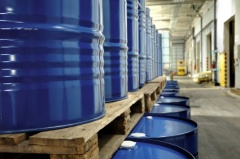Methyl Diisocyanate (MDI)
| Infobox on Methyl Diisocyanate (MDI) | |
|---|---|
| Example of Methyl Diisocyanate (MDI) |  |
| Facts | |
| Origin | - |
| Stowage factor (in m3/t) | - |
| Humidity / moisture | - |
| Ventilation | - |
| Risk factors | See text |
Methyl Diisocyanate (MDI)
Contents
Description
Methylene diphenyl diisocyanate, most often abbreviated as MDI, is an aromatic diisocyanate. It exists in three isomers, 2,2'-MDI, 2,4'-MDI, and 4,4'-MDI, however, the 4,4' isomer is most widely used. This isomer is also known as Pure MDI. MDI reacts with polyols in the manufacture of polyurethane. It is the most produced diisocyanate, accounting for 61.3% of the global market in the year 2000.
It is a light-yellow, fused solid. Soluble in acetone, benzene, kerosene and nitrobenzene.
Application
The major application of 4,4'-MDI is the production of rigid polyurethane. Typically, one tonne of polyurethane foam needs 0.616 tonne of MDI and 0.386 tonne of polyol, with 0.054 tonne pentane as a blowing agent. These rigid polyurethane foams are good thermal insulators and used in nearly all freezers and refrigerators worldwide, as well as buildings. Typical polyols used are polyethylene adipate (a polyester) and poly(tetramethylene ether) glycol (a polyether).
4,4'-MDI is also used as an industrial strength adhesive, which is available to end consumers as various high-strength bottled glue preparations.
Shipment / Storage
Solubility in Water (g/l): Insoluble, reacts slowly
Melting point: 40°C
Boiling point: 314°C
Flash point: 212–214°C
Solidification point: 37°C
For overseas carriage aspects of Chemicals, the readers are recommended to acquire or have access to a good chemical dictionary, and a copy of the International Maritime Dangerous Goods (IMDG) Code, issued by the International Maritime Organisation. Also consult the applicable MSDS sheet.
Risk factors
MDI is the least hazardous of the commonly available isocyanates but is not benign. Its very low vapour pressure reduces its hazards during handling compared to the other major isocyanates (TDI, HDI). However, it, like the other isocyanates, is an allergen and sensitizer. Persons developing sensitivity to isocyanates may have dangerous systemic reactions to extremely small exposures, including respiratory failure. Handling MDI requires strict engineering controls and personal protective equipment. Compared to other organic cyanates, MDI has a relatively low human toxicity. It is a potentially violently reactive material towards water and other nucleophiles. Combustible.











